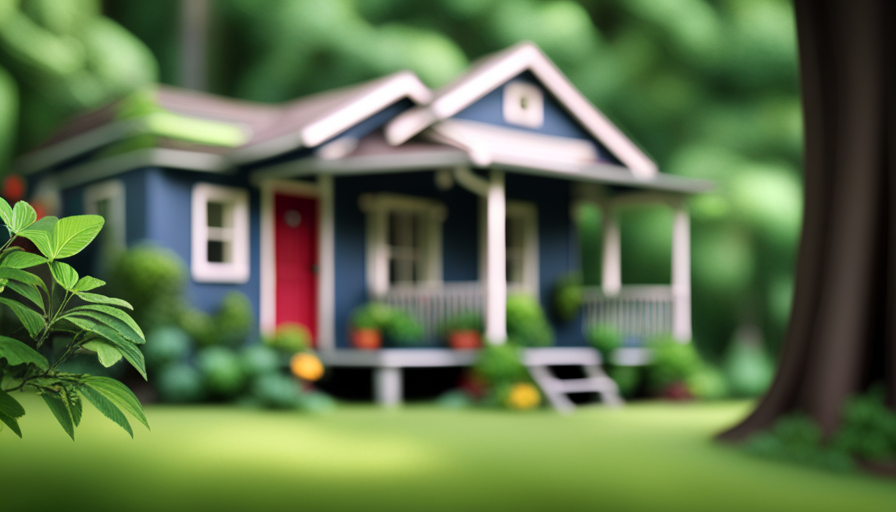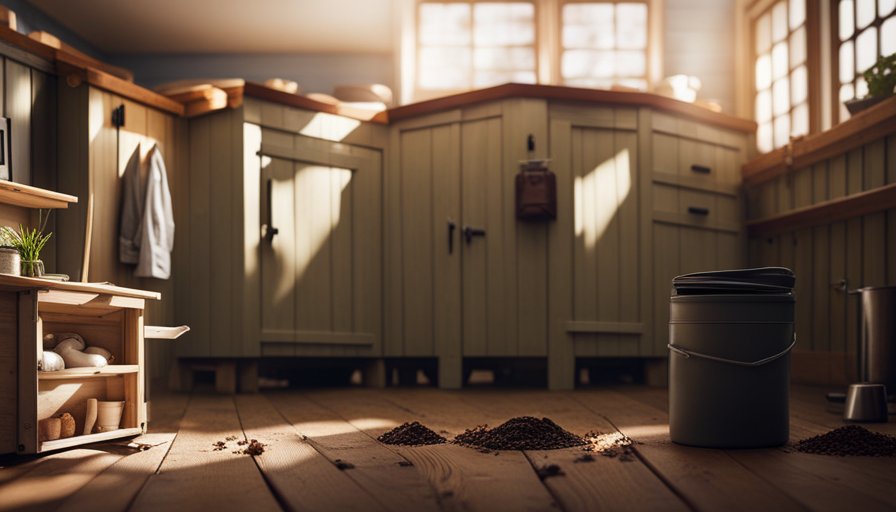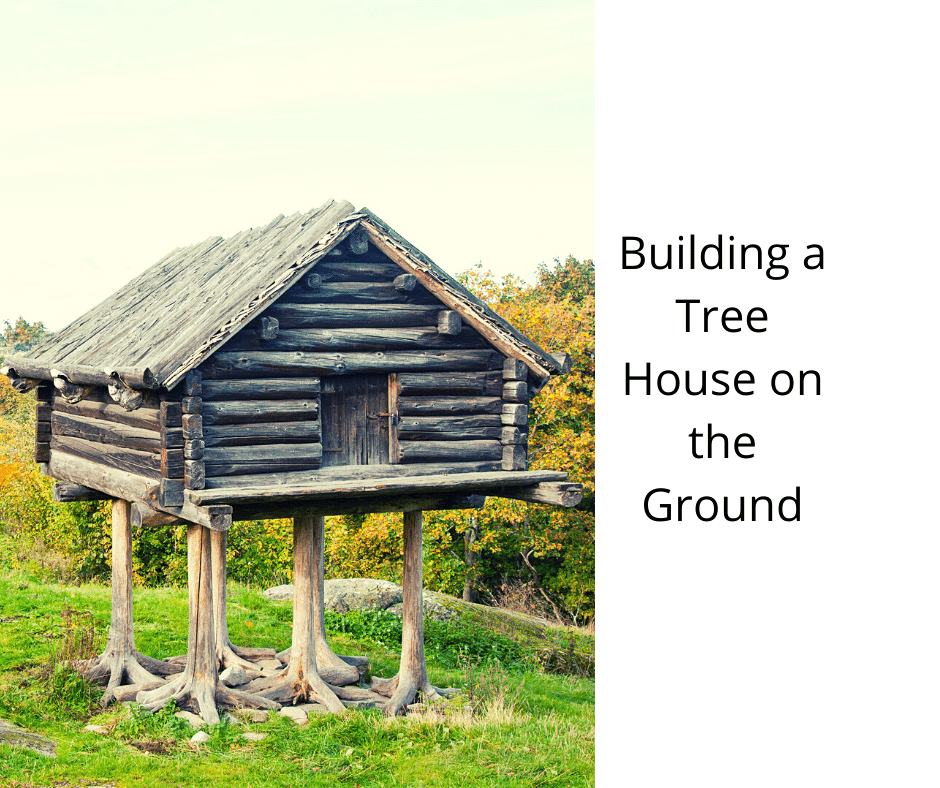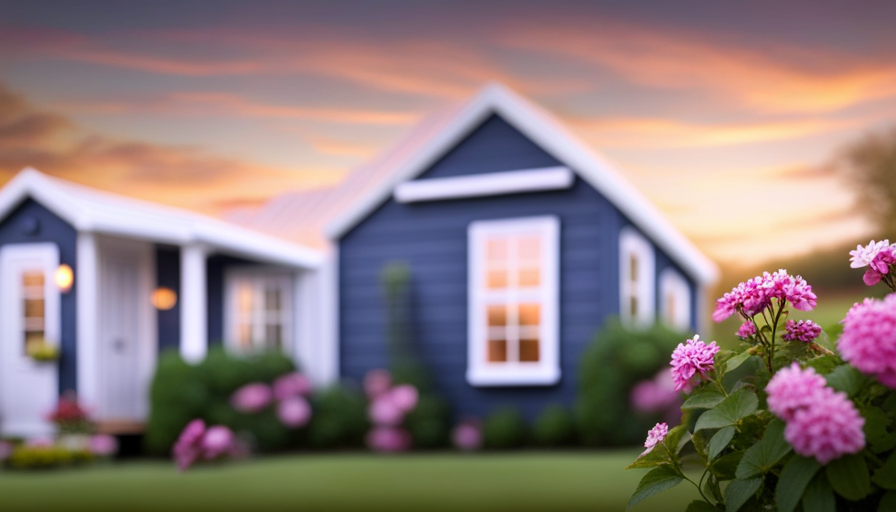Did you know that the average square footage of newly built homes in the United States has increased by more than 1,000 square feet in the past 40 years? This surprising statistic highlights our society’s obsession with obtaining bigger, better, and more abundant possessions.
However, there is a growing movement that challenges this norm and embraces a simpler, more sustainable way of living – the tiny house movement.
In this article, I will explore what the tiny house movement is, its historical background, core principles, and the benefits of living in a tiny house.
We will delve into the different types of tiny houses, their innovative designs and space optimization techniques, as well as the DIY building and customization options available.
Additionally, we will examine the unique community and lifestyle that comes with living in a tiny house and discuss the impact this movement has on the housing industry.
Finally, we will ponder the future of the tiny house movement and its potential to shape the way we live and interact with our environment.
Key Takeaways
- The Tiny House Movement challenges the obsession with bigger homes and embraces a simpler, more sustainable lifestyle.
- Tiny houses offer lower expenses, a simpler lifestyle, and more sustainable living options.
- Living in a tiny house requires a shift in mindset and a commitment to decluttering and simplifying.
- The movement has had a significant impact on the housing industry, influencing regulations, interior design, and urban planning.
Historical Background of the Tiny House Movement
The historical background of the tiny house movement can be traced back to the early 2000s. It emerged as a response to the increasing cost and size of traditional homes, along with a growing desire for a simpler, more sustainable lifestyle. The movement gained momentum through various factors, including the economic recession and the rise of social media platforms.
The tiny house movement has evolved significantly since its inception. Initially, it was primarily driven by individuals seeking to downsize and minimize their carbon footprint. However, it has now expanded to encompass a wide range of motivations, including financial freedom, mobility, and a desire for a closer connection to nature.
One of the key drivers behind the movement’s growth has been the development of innovative design and construction techniques. These allow for the creation of functional and aesthetically appealing tiny homes that maximize space and minimize waste. Additionally, the movement has been supported by a community of enthusiasts who share ideas, resources, and experiences through online platforms and in-person gatherings.
With a solid historical foundation and a growing community, the tiny house movement has become a significant force in the housing industry. In the subsequent section, we will explore the core principles of the movement and how they have shaped its development.
Core Principles of the Movement
The core principles of the tiny house movement revolve around minimalism and simplification of life, environmental sustainability, and financial freedom and debt reduction.
By embracing a minimalist lifestyle, individuals in the movement aim to reduce clutter and focus on what truly matters, prioritizing experiences over material possessions.
Additionally, tiny houses are designed to be environmentally sustainable, often utilizing renewable energy sources and eco-friendly materials.
Furthermore, the movement promotes financial freedom by advocating for smaller mortgage payments and reduced expenses, allowing individuals to live more freely and pursue their passions.
Minimalism and Simplification of Life
Contrary to popular belief, embracing minimalism and simplifying one’s life has become increasingly popular with millennials. A staggering 68% of them consider downsizing to a tiny house. This minimalist living trend is driven by a desire to live with less, reduce material possessions, and focus on experiences rather than material wealth.
By opting for a downsizing lifestyle, individuals can free themselves from the burden of excessive belongings. This leads to a simpler, more intentional way of life. Living in a tiny house allows for a more efficient use of space, encourages creativity in design, and promotes a sense of community.
Moreover, this shift towards minimalism aligns with the broader movement towards environmental sustainability. It encourages a smaller ecological footprint. With this in mind, let’s explore the connection between the tiny house movement and its commitment to environmental responsibility.
Environmental Sustainability
Imagine living in a space that not only meets your needs, but also allows you to make a positive impact on the environment around you. This is exactly what the tiny house movement offers, with its emphasis on environmental sustainability. Tiny houses are built using green building practices, which prioritize energy efficiency, use of sustainable materials, and minimal waste generation. By living in a tiny house, individuals can significantly reduce their carbon footprint, as these homes require less energy for heating, cooling, and overall maintenance. Additionally, the smaller size encourages a simpler lifestyle, promoting the use of renewable resources and reducing waste production. It’s amazing how such a small living space can have such a big impact on our planet. Transitioning into the next section about financial freedom and debt reduction, it’s important to understand the economic benefits of the tiny house movement.
Financial Freedom and Debt Reduction
Embrace the opportunity to unlock a world of financial freedom and liberation from debt by embracing the key principles of the tiny house movement. By choosing to live in a tiny house, you can experience significant financial benefits.
The reduced size of a tiny house means lower costs for construction, maintenance, and utilities. This allows for better financial planning and the opportunity to save money or pay off existing debts.
Furthermore, living in a tiny house encourages a minimalist lifestyle, where you prioritize what truly matters and avoid unnecessary expenses. This shift in mindset can lead to a more intentional and fulfilling approach to spending and saving.
By embracing the financial freedom and simplicity that comes with a tiny house, you can begin to experience the many benefits of living in this unique and innovative way.
Benefits of Living in a Tiny House
Living in a tiny house offers numerous benefits, such as lower expenses and a simpler, more sustainable lifestyle. One of the main financial advantages of living in a tiny house is the significant reduction in expenses. With a smaller space, utility bills are lower, and maintenance costs are minimal. Additionally, tiny houses are generally more affordable to purchase or build compared to traditional homes, allowing homeowners to save money or pay off debts more quickly.
Another benefit of living in a tiny house is the space efficiency it offers. Despite their small size, tiny houses are designed to maximize every inch of space. Clever storage solutions, multi-purpose furniture, and creative design allow for a comfortable living environment. This efficient use of space not only reduces clutter but also encourages a simpler lifestyle with fewer material possessions.
In addition to the financial advantages and space efficiency, living in a tiny house promotes a more sustainable lifestyle. Tiny houses require fewer resources to build and maintain, reducing their carbon footprint. They also encourage individuals to adopt minimalist habits and prioritize experiences over material possessions. Furthermore, living in a smaller space often leads to a closer connection with nature, as tiny houses are often built in scenic locations or on wheels for easy mobility.
Transitioning to the next section about different types of tiny houses, it is important to explore the various options available to suit individual preferences and needs.
Different Types of Tiny Houses
There are a variety of compact dwellings that cater to different tastes and requirements. When it comes to tiny houses, there are several different types to choose from.
One popular type is the traditional tiny house on wheels, which is built on a trailer and can be easily transported. These houses usually range from 100 to 400 square feet and are designed to maximize space efficiency.
Another type of tiny house is the container home, which is made from repurposed shipping containers. These homes aren’t only environmentally friendly, but they also offer a unique and modern aesthetic.
Additionally, there are tiny houses made from sustainable materials, such as reclaimed wood or recycled materials. These houses are perfect for those who want to minimize their carbon footprint and live a more eco-friendly lifestyle.
Lastly, there are tiny houses designed for off-grid living, with features like solar panels, composting toilets, and rainwater collection systems. These houses allow you to live completely self-sufficiently, even in remote locations.
With so many options to choose from, there is a tiny house out there for everyone.
In the next section, we’ll explore the various design and space optimization techniques used in tiny houses, allowing you to make the most of your compact living space.
Design and Space Optimization in Tiny Houses
Now that we’ve explored the different types of tiny houses, let’s delve into the fascinating world of design and space optimization in these unique dwellings.
The tiny house movement has spurred a wave of design innovation, as homeowners and builders find creative ways to make the most out of limited space. One of the key aspects of tiny house design is the use of space-saving techniques. Every inch counts in these compact homes, so maximizing storage and functionality is crucial.
From built-in shelving units to multipurpose furniture, such as beds that double as storage or tables that fold away when not in use, there are countless ingenious solutions to save space.
Additionally, the layout and flow of a tiny house must be carefully considered to ensure efficient use of every square inch. Open floor plans, strategically placed windows, and thoughtful organization systems help create a sense of spaciousness and make the most of natural light.
As we delve deeper into the challenges and considerations of living in a tiny house, it becomes clear that these design and space optimization techniques play a vital role in making tiny living not only possible, but also enjoyable and fulfilling.
Challenges and Considerations of Living in a Tiny House
Amidst the cozy charm and ingenious design solutions, one can’t help but consider the unique challenges that come with embracing the tiny house lifestyle. Minimal living and space limitations are two key aspects that require careful consideration when living in a tiny house.
Living in a tiny house means embracing a minimalist lifestyle. Every item must serve a purpose and have a designated place for storage. It requires a shift in mindset and a commitment to decluttering and simplifying one’s life. The limited space also means that creative storage solutions are a must. From utilizing vertical space with wall-mounted shelves to incorporating multi-functional furniture, every inch of a tiny house needs to be optimized.
Another challenge of living in a tiny house is the lack of privacy. With limited rooms and open floor plans, it can be difficult to find a quiet space for oneself. Additionally, living in such close quarters with others requires strong communication and compromise.
To better understand the challenges of living in a tiny house, let’s take a closer look at a comparison table:
| Challenge | Solution | Benefit |
|---|---|---|
| Limited space | Creative storage solutions | Maximizes use of space |
| Lack of privacy | Open communication and compromise | Stronger relationships |
| Limited amenities | Off-grid options | Lower environmental impact |
As we delve into the next section about DIY building and customization of tiny houses, we will explore how individuals tackle these challenges and create unique living spaces that reflect their personal style and needs.
DIY Building and Customization of Tiny Houses
Embrace the freedom to create your own unique living space by taking on the challenge of DIY building and customization in the world of tiny houses. With the rise of the tiny house movement, more and more people are opting to build their own homes using DIY building techniques. This not only allows for greater customization options, but also provides a sense of accomplishment and pride in creating a space that perfectly suits your needs and preferences.
When it comes to DIY building, there are a variety of techniques that can be used. From traditional stick-built construction to alternative methods like shipping container conversions or using salvaged materials, the possibilities are endless.
Many DIY builders also choose to incorporate sustainable and eco-friendly practices into their projects, such as installing solar panels or using reclaimed materials.
In addition to the building process, customization is a key aspect of tiny house living. From interior design choices to space-saving solutions, there are countless customization options and ideas to explore. Some popular customization choices include built-in storage, multipurpose furniture, and creative use of vertical space.
As you delve into the world of DIY building and customization, you’ll find that it’s not just about creating a home, but also about embracing a unique lifestyle. The community and lifestyle of tiny house dwellers is a supportive and close-knit one, where individuals share ideas, tips, and resources. So, let’s delve into the next section and explore the community and lifestyle of tiny house dwellers.
Community and Lifestyle of Tiny House Dwellers
I want to talk about the sense of community and connection that comes with living in a tiny house.
One of the key aspects of the tiny house movement is the creation of tiny house communities and co-housing arrangements, where like-minded individuals come together to live in close proximity and share resources and skills.
Living in a tiny house allows for a more intentional and sustainable way of living, and being part of a community adds an extra layer of support and camaraderie.
Tiny House Communities and Co-Housing
Imagine yourself strolling through a vibrant tiny house community, where colorful cottages are nestled together like a whimsical village, and the sense of camaraderie fills the air. Tiny house communities, also known as intentional communities, have become a popular option for those seeking a simpler and more sustainable way of living.
These communities offer a unique opportunity for tiny house co-living, where individuals come together to share resources and create a supportive environment. Within these communities, you’ll find a variety of amenities and shared spaces such as communal gardens, workshops, and gathering areas. The close proximity of the houses encourages social interaction and fosters a strong sense of community. It’s truly a place where neighbors become friends and where skills and knowledge are shared freely.
Transitioning into the next section, sharing resources and skills is a fundamental aspect of tiny house living.
Sharing Resources and Skills
Tiny House Communities and Co-Housing have created a sense of belonging and support among like-minded individuals. As we strive for a simpler and more sustainable way of living, the Tiny House Movement has also fostered a culture of resource sharing and skill exchange.
In these communities, there is a strong emphasis on collaboration and cooperation, where members come together to share tools, equipment, and even land. This not only reduces individual costs but also promotes a more efficient use of resources.
Moreover, residents often organize skill-sharing workshops and classes, where they can learn from each other and develop new abilities. By embracing the concept of resource sharing and skill exchange, the Tiny House Movement encourages a more self-reliant and interconnected lifestyle.
This sense of community and connection is at the heart of the movement, and it will be further explored in the next section.
Sense of Community and Connection
Experience a deep sense of community and connection as you immerse yourself in the world of Tiny House living. One of the most remarkable aspects of the Tiny House movement is the strong community support and social connections that are fostered among its residents. Living in a Tiny House often means being part of a like-minded community that shares resources, knowledge, and skills. Whether it’s organizing communal gardens, hosting regular potluck dinners, or collaborating on DIY projects, Tiny House dwellers find solace in the company of others who understand and appreciate their lifestyle choices.
To illustrate the sense of community in the Tiny House movement, imagine a table with three columns: one for resources, one for skills, and one for needs. Each row represents a Tiny House resident, listing what they can offer, what they need, and what skills they possess. This table becomes a hub for connecting and supporting each other, fostering a strong sense of belonging and camaraderie.
As the Tiny House movement continues to grow, its impact on the housing industry is undeniable. Transitioning to the next section, let’s explore how this movement is reshaping the way we think about housing and its potential long-term effects.
Impact of the Tiny House Movement on the Housing Industry
The Tiny House Movement has had a significant impact on the housing industry in several ways.
Firstly, it has influenced architecture and design by promoting smaller, more efficient living spaces that prioritize functionality and sustainability.
Secondly, it has sparked changes in housing policies and regulations, as governments are recognizing the need to accommodate alternative housing options and are revising zoning and building codes accordingly.
Lastly, the movement has provided an alternative solution to the affordable housing crisis, offering individuals and families a more affordable and sustainable option for homeownership.
Influence on Architecture and Design
Influencing the very foundations of traditional architecture and design, the tiny house movement has breathed new life into the industry, like a gust of fresh air sweeping through a stuffy room. This movement has not only impacted the housing industry but has also influenced interior design and urban planning.
-
Influence on Interior Design:
-
Emphasis on multi-functional spaces, maximizing every square inch.
-
Creative storage solutions like hidden compartments and built-in furniture.
-
Impact on Urban Planning:
-
Encourages compact and sustainable living in urban areas.
-
Promotes the use of shared spaces and community-oriented design.
The tiny house movement has sparked a reimagining of how we design and utilize space. Its influence on interior design and urban planning has challenged traditional norms and pushed for innovative solutions.
As we delve into the subsequent section about changes in housing policies and regulations, we can see how the tiny house movement has prompted a broader conversation about alternative housing options and the need for flexibility in regulations.
Changes in Housing Policies and Regulations
One significant outcome of the tiny house phenomenon has been the reformation of housing policies and regulations to accommodate alternative living options. Changes in housing policies, regulations, and zoning restrictions have allowed for the increased affordability and accessibility of tiny houses.
Many local governments have recognized the benefits of tiny houses, such as their potential to address the affordable housing crisis and reduce environmental impact. As a result, they have revised their regulations to allow for smaller dwelling sizes and eased restrictions on land use. These changes have created more opportunities for individuals and families to pursue the tiny house lifestyle, providing a viable housing solution for those seeking a simpler and more sustainable way of living.
With the improvements in housing policies, it’s now easier than ever for people to explore alternative housing solutions for the affordable housing crisis.
Alternative Housing Solutions for Affordable Housing Crisis
After exploring the changes in housing policies and regulations, it’s clear that the affordable housing crisis is a pressing issue that needs innovative solutions.
This is where the tiny house movement comes into play, offering alternative housing solutions that are gaining popularity across the country. These tiny homes, with their innovative design and compact size, provide an affordable and environmentally-friendly option for individuals and families struggling with the high cost of housing.
By utilizing efficient use of space and incorporating sustainable materials, these homes offer a way to combat the housing crisis while minimizing environmental impact. However, the future of the tiny house movement is still uncertain, as it faces challenges such as zoning restrictions and limited access to financing.
Nonetheless, the movement continues to grow, offering hope for a more affordable and sustainable housing future.
Future of the Tiny House Movement
The future of the Tiny House Movement looks bright, with its potential to soar like a bird in the sky, bringing freedom and simplicity to those who embrace its charm. As the movement gains momentum, there are several future trends and technology integrations that are expected to shape its growth:
-
Innovative Designs: Architects and designers are constantly pushing the boundaries of tiny house design, creating innovative and functional spaces that maximize every square inch. From foldable furniture to multi-purpose storage solutions, these designs will continue to evolve and cater to the needs of tiny house dwellers.
-
Sustainable Living: With an increasing focus on environmental consciousness, the future of the Tiny House Movement will see a greater emphasis on sustainable and eco-friendly living. This includes the integration of renewable energy sources such as solar panels, rainwater harvesting systems, and composting toilets.
-
Smart Home Technology: As technology continues to advance, tiny houses will become smarter and more connected. From voice-controlled assistants to automated systems for temperature control and security, technology integration will enhance the convenience and comfort of tiny house living.
-
Community Development: Tiny house communities are on the rise, offering a sense of belonging and shared resources. In the future, these communities will continue to flourish, providing a supportive network for like-minded individuals and fostering a sense of community.
With these future trends and technology integrations, the Tiny House Movement is set to revolutionize the housing landscape, providing affordable and sustainable housing options for those seeking a simpler way of life.
Frequently Asked Questions
What is the average cost of building a tiny house?
The average cost of building a tiny house can vary depending on whether it is a DIY or professional build. DIY builds can range from $10,000 to $30,000, while professional builds can cost between $30,000 and $150,000.
Are there any legal restrictions or regulations for living in a tiny house?
Living in a tiny house presents legal challenges due to zoning regulations. It’s like trying to fit a square peg into a round hole. These restrictions can limit where you can park or build your tiny home.
How do tiny house dwellers handle utilities such as water, electricity, and sewage?
When it comes to off-grid living and sustainable living, tiny house dwellers handle utilities like water, electricity, and sewage by using alternative sources such as rainwater collection, solar panels, composting toilets, and off-grid energy systems.
Can tiny houses be moved easily or are they typically stationary?
Tiny houses are designed to be easily moved, making them highly portable. This allows for flexibility in choosing where to live and the ability to travel. However, there are also benefits to stationary living, such as stable utilities and a sense of community.
Are there any financing options available specifically for buying or building a tiny house?
Are there any financing options for buying or building a tiny house? Yes, there are various tiny house financing options available, such as tiny house loans, that can help make owning a tiny house more affordable and accessible.
Conclusion
In conclusion, the tiny house movement has gained significant traction in recent years, offering a unique and sustainable way of living. With its core principles of simplicity, affordability, and environmental consciousness, it has become a viable alternative to traditional housing options.
One interesting statistic is that the average size of a tiny house is around 400 square feet, compared to the average American home size of 2,600 square feet. This shows the drastic difference in space utilization and highlights the movement’s focus on minimalism and efficient living.
The future looks promising for the tiny house movement as more individuals embrace this lifestyle and the housing industry adapts to meet the demands of this growing trend.
Hi, I’m Emma. I’m the Editor in Chief of Tiny House 43, a blog all about tiny houses. While tree houses are often associated with childhood, they can be the perfect adult retreat. They offer a cozy space to relax and unwind, surrounded by nature. And since they’re typically built on stilts or raised platforms, they offer stunning views that traditional homes simply can’t match. If you’re looking for a unique and romantic getaway, a tree house tiny house might just be the perfect option.










